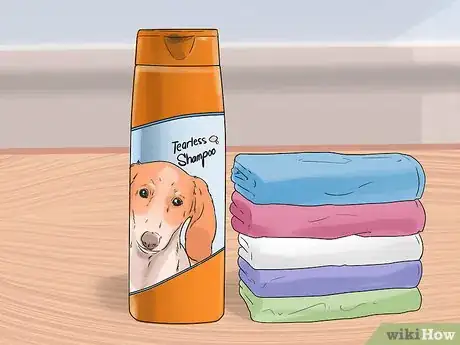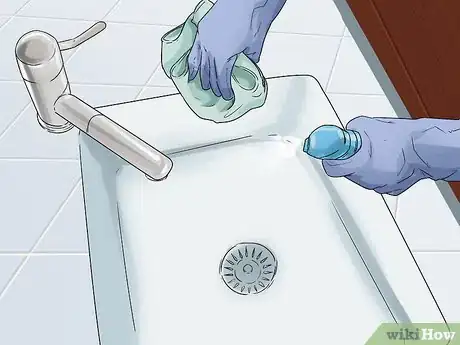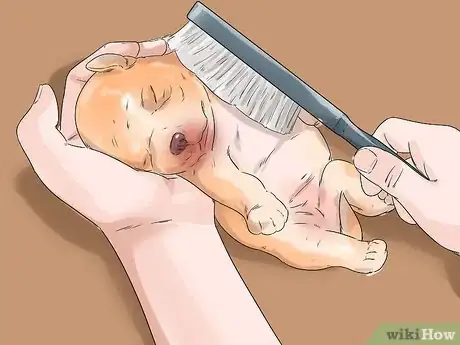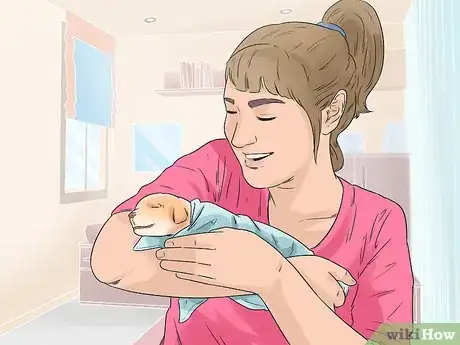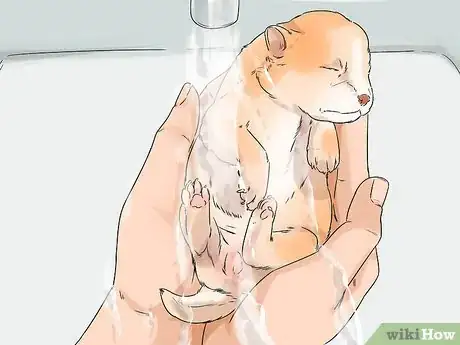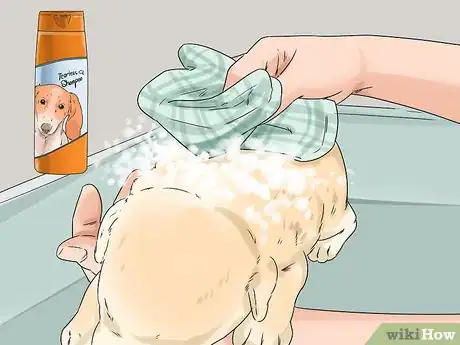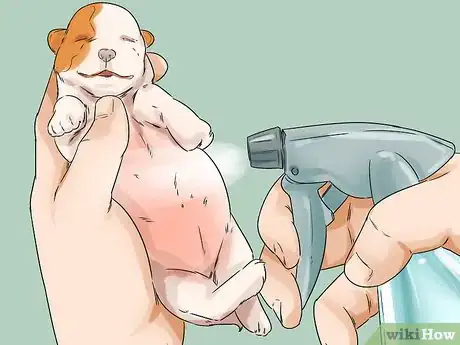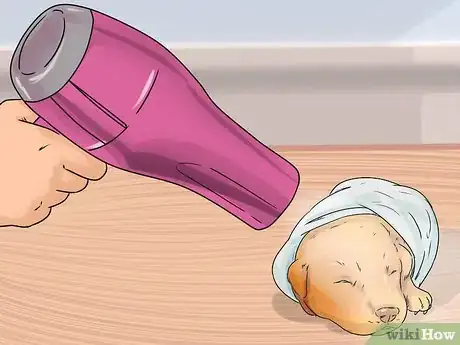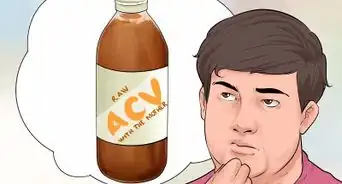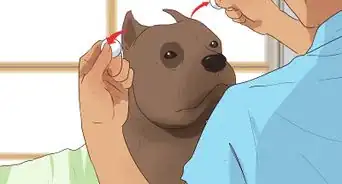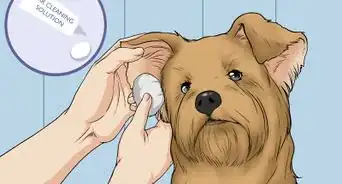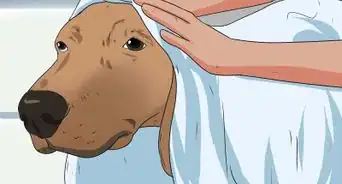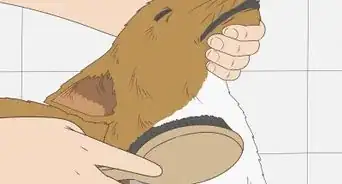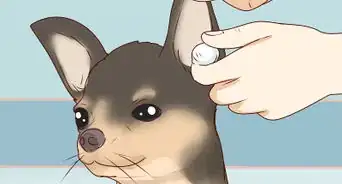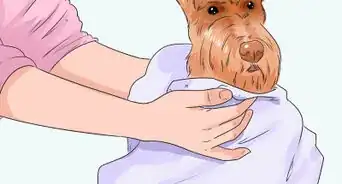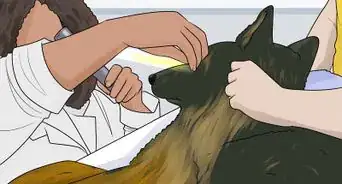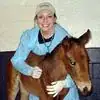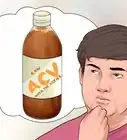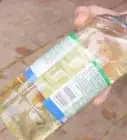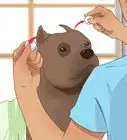This article was co-authored by Ryan Corrigan, LVT, VTS-EVN. Ryan Corrigan is a Licensed Veterinary Technician in California. She received her Bachelor of Science in Veterinary Technology from Purdue University in 2010. She is also a Member of the Academy of Equine Veterinary Nursing Technicians since 2011.
There are 7 references cited in this article, which can be found at the bottom of the page.
This article has been viewed 57,106 times.
Newborn puppies may be adorable, but they can poop and make a mess too. Little puppies can also get germs because they are always around each other, so it is important to make sure your newborn puppies maintain a high level of hygiene. Normally, the puppies’ mother will clean the them, but there may be times when you have to bathe them yourself. You can usually bathe a newborn puppy in your kitchen sink, but you must be sure to keep your puppy warm at all times.
Steps
Getting Ready
-
1Gather the necessary supplies. If you want to bathe your newborn puppy, you’ll need to make sure you have a few things you’ll need in the process. Purchase some tearless shampoo intended for use on young puppies. This will be gentler for the puppy, especially if it gets in the puppy’s eyes on accident. You’ll also need some warm towels, a wash cloth, a bucket of warm water, a nonslip mat, and a hair dryer.[1]
- Never use human shampoo on newborn puppies as most products contain chemicals that could be harmful for your tiny pup.
-
2Clean the area. Since newborn puppies have fairly weak immune systems, you need to make sure the bathing area is clean before you introduce the puppy to possible germs. Use a natural cleaning solution to wipe down the area as harsh chemicals found in many cleaners could be harmful to the puppy as well.
- For example, if you are bathing the puppy in the kitchen sink, make sure you clean up any food remnants or germs that the puppy could be exposed to.
Advertisement -
3Brush your puppy. Brushing your puppy is an important part of getting ready for bath time. Since water can worsen mats and tangles that already exist in their coat, it is important to brush these out before you get your pup wet. Spend a few minutes brushing your puppy’s coat out so that there are no more tangles.[2]
- Regularly brushing your puppy’s coat will also help decrease the required frequency of baths because it helps keep your puppy clean.
Keeping Your Puppy Warm
-
1Use warm water. Since puppies have a hard time maintaining their own body temperature, it’s important that you keep them warm during bath time. The main thing you need to worry about is using warm water (not too hot though) during the bathing process. Use water that is comfortable on your own skin to wet the puppy down and to rinse out the shampoo.
- Test the water with your hand before getting the puppy wet so that you can make sure it is not too hot or too cold. If you can't keep your hand comfortably in the water, then it is too hot for a newborn puppy.
-
2Warm up towels before use. Once the puppy is wet, it’s even more important to take steps to keep it warm. Use towels that are warmed slightly to keep the newborn puppy’s body temperature up while it is wet. You can put the towels in the dryer for a couple of minutes to heat them up a bit.[3]
- You can also hold the puppy against your skin while it is wrapped in the towel to use your own body heat to help the puppy stay warm.
-
3Plan to stay indoors. After bathing your puppy, you want to make sure it stays inside your warm, heated house rather than going outside where the cold air could drastically affect the puppy’s body temperature with its damp fur. Keep the puppy inside the house where it can stay warm.[4]
- You also don’t want your puppy to go roll around in something that could get it dirty again after you’ve just gone to the trouble of bathing it.
- Your puppy will probably want to sleep after its bath, so make sure its bed is warm and cozy for it to nap in.
Bathing Your Newborn Puppy
-
1Wet your puppy down. Use warm water to get your puppy’s fur wet. Put the puppy on a nonslip mat in the sink and use a measuring cup to slowly pour water over it. Start at the back end and move forward from there so that your puppy gets used to it and doesn’t panic.[5]
- Do not place the puppy in a tub, as this is dangerous at this age. It's also frightening to the puppy.
- You should also avoid using a dish-spray hose, as it will spray too hard for use on a puppy.
- Be careful not to get the water in the puppy’s eyes, as this will cause discomfort for the puppy and make it struggle against the bath even more.
-
2Apply the shampoo. Use a warm washcloth to work the shampoo into your puppy’s coat. Apply a small amount of the shampoo onto the washcloth and gently rub it all over your puppy’s body. Keep the shampoo out of your puppy’s eyes, ears, and nose to avoid discomfort.[6]
- Be sure to keep one hand on the puppy, keeping it stable, while you use the other hand to rub the washcloth around on the puppy’s body. It's a good idea to place the stabilizing hand under the puppy to keep it supported.
- Remember to get the dog’s ears, butt, stomach, legs, paws, back, belly, and neck while washing.
-
3Rinse the dog. Use the dish-spray hose again to gently spray warm water on your puppy to get the shampoo out. Begin at the rear end and work your way forward, making sure you get all of the soap suds out as you go.[7]
- Alternatively, you could use a cup that you fill with warm water over and over to rinse out the shampoo.
-
4Dry your puppy. Once you are done bathing your newborn puppy, you need to act quickly to get your puppy warm and dry again. Use a warm towel to rub the puppy and soak up any excess water.[8]
- If you feel comfortable doing so, you can use a hairdryer on the puppy after you have towel-dried it. Make sure you put the hairdryer on a low setting so that it doesn’t get too hot for the puppy and so the sound will be a bit quieter.
Expert Q&A
-
QuestionHow do I get rid of fleas on a two week old puppy?
 Ryan Corrigan, LVT, VTS-EVNRyan Corrigan is a Licensed Veterinary Technician in California. She received her Bachelor of Science in Veterinary Technology from Purdue University in 2010. She is also a Member of the Academy of Equine Veterinary Nursing Technicians since 2011.
Ryan Corrigan, LVT, VTS-EVNRyan Corrigan is a Licensed Veterinary Technician in California. She received her Bachelor of Science in Veterinary Technology from Purdue University in 2010. She is also a Member of the Academy of Equine Veterinary Nursing Technicians since 2011.
Licensed Veterinary Technician Gently use a soapy comb to help remove the fleas from the puppy. Call your veterinarian about what products they can give you to kill the fleas. Don’t forget to treat the environment. Do not give your puppy any medications to kill the fleas, as they are too little, and most products will be toxic to a two week old puppy.
Gently use a soapy comb to help remove the fleas from the puppy. Call your veterinarian about what products they can give you to kill the fleas. Don’t forget to treat the environment. Do not give your puppy any medications to kill the fleas, as they are too little, and most products will be toxic to a two week old puppy.
Warnings
- Make sure you dry the dog thoroughly.⧼thumbs_response⧽
- Do not put a newborn puppy in a tub, as the puppy could drown or otherwise hurt itself.⧼thumbs_response⧽
- A puppy must be at least four months old to get bathed in a bathtub.⧼thumbs_response⧽
Things You'll need
- Small Washcloth
- Baby Shampoo
References
- ↑ http://www.fidosavvy.com/bathing-a-puppy.html
- ↑ http://www.all-about-goldens.com/bathing-a-puppy.html
- ↑ https://www.cesarsway.com/dog-care/puppies/caring-for-a-newborn-puppy
- ↑ http://www.vcahospitals.com/main/pet-health-information/article/animal-health/breeding-for-dog-owners-caring-for-newborn-puppies/488
- ↑ http://www.hartz.com/Dogs/Hartz_Puppy/bathtime_for_puppies.aspx
- ↑ http://www.yorkieinfocenter.com/newborn-yorkies
- ↑ http://www.fidosavvy.com/bathing-a-puppy.html
- ↑ http://www.peteducation.com/article.cfm?c=2+2095&aid=824
About This Article
Before you give your newborn puppy a bath, brush its fur to remove any mats or tangles, since exposure to water can make these worse. Next, place your puppy on a non-slip mat in the sink, and slowly pour warm water over it with a measuring cup. Try to start from the back of the puppy and work towards its head, which will give it time to get used to the water. Once your puppy’s fur is wet, apply a small amount of shampoo to a warm washcloth and rub it all over its coat. However, avoid getting the shampoo into its ears, eyes, and nose, since it may cause irritation. As you rub in the shampoo, stabilize it with your other hand so it doesn’t fall over. Afterwards, rinse out the shampoo by pouring warm water over its fur. Finish by drying your puppy with a warm towel to prevent it from catching a chill due to its wet coat. For tips from our Veterinary co-author, including how to prepare the bathing area, keep reading!
